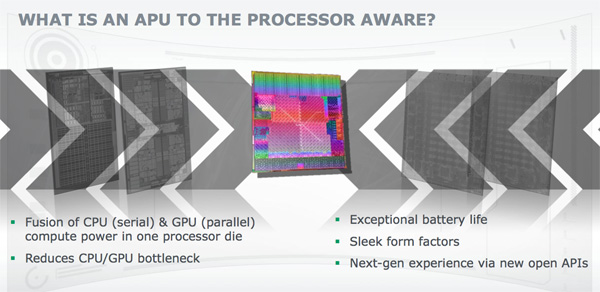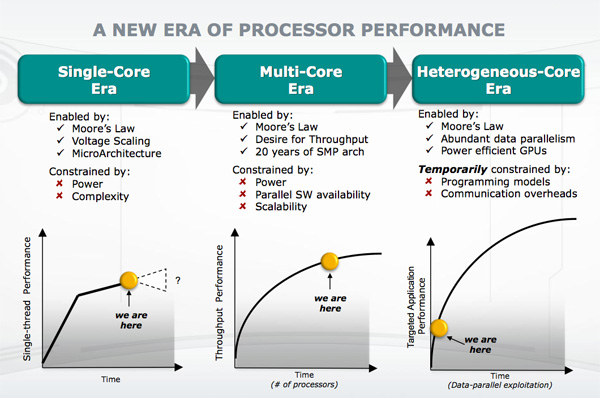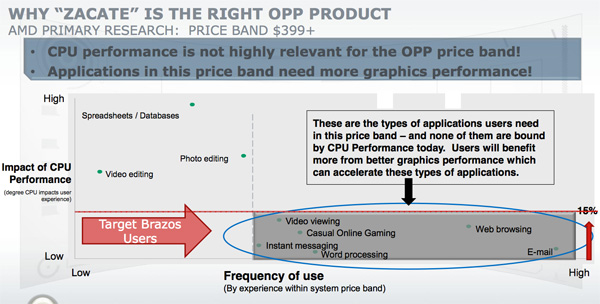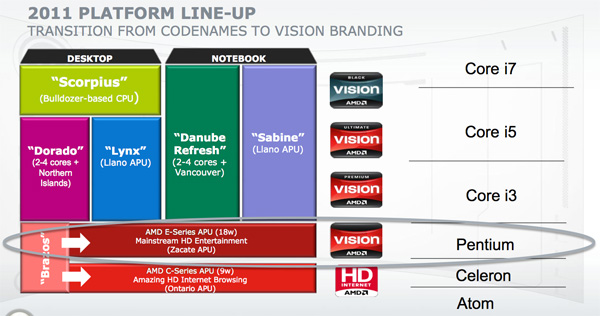Previewing AMD's Brazos, Part 1: More Details on Zacate/Ontario and Fusion
by Anand Lal Shimpi on November 9, 2010 1:09 AM ESTI hate to keep things from you all, but last week I was diligently working in a room at AMD’s new campus in Austin, Texas. You see, AMD wanted to give us more time with the Brazos/Zacate platform we tested at IDF ahead of its official launch. It’s too early for production worthy OEM systems and AMD wasn’t too keen on these reference platforms leaving its offices so it did the next best thing: fly us out to test the systems on AMD’s campus.
The rules were simple. We couldn’t run anything that would harm the system, but other than that we were free to bring whatever we wanted and test however we wanted. AMD dropped by our private room to check to see if we needed anything but other than that, it was all hands off.

The Brazos test platform
While I’d love to share performance data with you today, I can’t. You’ll have to wait another week or so for that. What AMD is allowing us to talk about are the specific configurations AMD’s first Fusion APUs will ship in and general impressions from the testing. Specific benchmarks are off limits unfortunately.
The platform felt final as far as stability goes. I didn’t encounter any crashes during my several hours of non-stop testing. Performance is also indicative of what will ship early next year. The system felt quick (very 11-inch MacBook Air like if you catch my drift) but you have to keep in mind that Zacate and its lower powered sibling Ontario will be used in systems priced between $299 - $549.














106 Comments
View All Comments
Dark_Archonis - Wednesday, November 10, 2010 - link
You're right, and as I said, the iPad is likely not the ONLY cause.However, the fact remains that netbook sales are collapsing and I don't see them improving.
mino - Thursday, November 11, 2010 - link
"Netbook" sales are collapsing for 2 reasons:1) crappy performance
2) stupid Intel restrictions
Both of which are to be remedied by Ontario ...
Dark_Archonis - Wednesday, November 10, 2010 - link
Funny you mention that, as AMD is in a similar situation. Bobcat is too power-hungry to compete with ARM, but it doesn't have enough performance to direct compete with Celerons, Pentiums, and i3s. Bobcat will have more CPU performance than Atom it seems, but to what end?AMD has Intel on one side and Apple on the other side. As I already said, netbooks are facing direct competition from the iPad. This is competition that BOTH Intel and AMD have to deal with. For laptops, i3 and i5 processors still reign supreme in terms of CPU performance, heat, and power efficiency. Sandy Bridge laptops will significantly improve GPU performance.
Intel is trying to put most of its Atom focus to TVs, HTPCs, tablets, and phones. Of course they face competition from ARM and Apple.
Atom may be too power-hungry at the moment, but future Atoms will further decrease the TDP to far below Bobcat levels.
ze_troll - Wednesday, November 10, 2010 - link
LAST TIME I CHECKED BRO I DUN THINK ANYTHING IS DIRECTLY COMPETING WITH CELERONS AND PENTIUMS BCUZ THEY R DED TEKNOLOGEES.HEY DARK_ARSCHONIS, THE YEAR 2000 CALLED, THEY WANT THEIR CPU BACK LOL
Dark_Archonis - Wednesday, November 10, 2010 - link
http://www.toshibadirect.com/td/b2c/cdetland.to?po...http://www.bestbuy.com/site/Toshiba+-+Satellite+La...
Look, CELERON and PENTIUM processors for sale. Just because they still carry old names, does not mean they are dead technology. They are Core and Core 2-based CPUs simply renamed.
Now go back under your bridge troll.
Zoolookuk - Wednesday, November 10, 2010 - link
Lots of comments here about this Vs Atom, but I think people are entirely missing the point about ultra-low power devices.First of all, what about ARM? The AMD/Intel rivalry is interesting if people still think that small devices will run Windows 7 Professional, or even OS X, but the reality is that OSes are changing. Android and most obviously iOS work differently, and I suspect that even OS X is moving much more towards GPGPU capabilities that make the CPU almost secondary.
RISC and APU designs will be far more important in the next 5 years than they were in tghe last 15 years, and because of this, Intel probably has the biggest hill to climb. AMD understood this in 2006, which is why they bought ATI.